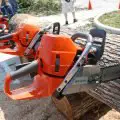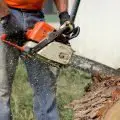Most chainsaw users frequently have a common problem while trying to start their chainsaws. But their chainsaw won’t even start to spark or burn fuel. Have you ever been drawn into one of these situations by your chainsaw? Nevertheless, despite your best efforts, there are a number of potential causes for such an issue.
Anybody could experience this, whether they are using a chainsaw for regular or personal use that is new or old. Knowing the causes is always preferable so you can resolve your problems.
Today we’ll discuss some of the main reasons why a chainsaw won’t start, along with solutions.
Table of Contents
- Common Issues Why Chainsaw Hard to Start
- Why Doesn’t Your Chainsaw Start Even if It has Spark and Fuel? Top 3 Causes & Solutions
- Chainsaw Won’t Start Has Spark and Fuel? Additional Possibilities
- FAQs (Frequently Asked Questions)

Common Issues Why Chainsaw Hard to Start
| Problem | Solution |
|---|---|
| Spark Arrestor Blocked | Replace the spark arrestor after every 24 hours of use. |
| Dirty Spark Plug | 1. Detach the electrodes and clean them with an emery cloth. 2. Clean the electrodes with a wire brush or scrape off deposits with a knife. 3. Replace the spark plug if the problem persists. |
| Dirty Air Filter | 1. Remove the air filter from the chainsaw. 2. Use an air compressor to blow dust from the inside out, using low pressure (below 20 psi). 3. If the compressor doesn’t have a low-pressure option, keep a safe distance from the filter. 4. For foam air filters, clean with soap and water if the compressor method is not compatible. |
| Clogged Carburetor | 1. Clean the carburetor’s air intake components with a spray cleaner. 2. Clean the needle valves and drain the washing agents. 3. Slowly pull the chainsaw’s cord to dissolve gooey residue with the fuel-cleaning agent combo. 4. Discard the old fuel from the tank and replace it with new fuel before starting the chainsaw. |
| Damaged Clutch Pads | Replace the entire clutch plate set. |
| Worn Out Compression Rings | Replace the compression rings if they are exhaling bluish fumes or if sooty deposits frequently develop on the spark plug. |
| Flooded Engine | Drain excess fuel and use fresh fuel for a quick start. |
| Clogged Fuel Filter | Periodically change and clean the fuel filter after a few uses. |
| Faulty Ignition Coil | Check for errors with a multimeter or an ignition coil tester and replace the coil if necessary. |
| Damaged Recoil Starter Components | Inspect and replace the rewind spring, recoil starting pulley, or magneto assembly if damaged or worn out. |
Why Doesn’t Your Chainsaw Start Even if It has Spark and Fuel? Top 3 Causes & Solutions
Examine the technical issues and damages that may be causing your chainsaw to ignite but not start. Recognize the problems and address them at their source.
Spark Arrestor
Due to the exhausting spark particles, the spark arrestor prevents fire during the dry season. But with time, it becomes blocked unintentionally, making it difficult to burn the new fuel-air mixture thoroughly. Therefore, it needs to be replaced after every 24 hours of use in order to avoid this circumstance.
How to Clean the Spark Plug
1. Detach the Electrodes
Use an emery cloth to scrub the carbon off the electrode. On the opposing surface, the other electrode protrudes from the metal base. You ought to take it out, too.
2. Clean the Electrodes
After detaching them, clean them with a wire brush. Scrape off deposits with a knife if they are particularly resistant to removal. This ought to be sufficient to completely clean the spark plug hole. It could be necessary to replace the item if the problem still exists. The fact that spark plugs are reasonably priced is a plus.
Dirty Air Filter
Air filters that are dirty and clogged contribute to the saw’s inability to start. After using the air filter for five hours, remove it and clean it.
How to Unclog the Air Filter
1. Take Off the Air Filter
First things first, take the chainsaw’s air filter off. Cleaning the filter while it is inside is never a good idea.
2. Get Rid of the Dust
Select an air compressor now and use it to remove the dust from the inside out. Make sure to blow inside out rather than outside in.
3. Lower the Air Pressure
Another thing to keep in mind is that high air pressure is not compatible with chainsaw air filters. As a result, turn the compressor to the lowest setting—ideally below 20 psi.
4. Keep a safe distance from the filter
Unfortunately, low-pressure options are not available on all compressors. If so, lower the setting as much as you can and move the compressor farther from the filter.
Although this is a good way to clean air filters, some chainsaws might not be compatible. Try cleaning your filter with soap and water if you have one like that. However, soap washing is only effective if your chainsaw has a foam air filter rather than a paper one.
Clogged Carburetor
A blocked carburetor may prevent your chainsaw from starting. Such blockage is typically caused by fuel evaporation. To avoid unintended clogs, you must routinely clean the gas tank and the carburetor.
How to Clean the Carburetor
Total Time: 5 minutes
Clean the Intake Components
The first step is to clean the carburetor’s air intake components. A spray cleanser will expedite the process.
Clean the Needle Valves
The carburetor’s needle valves should also be cleaned, and the washing agents should be drained.
Pause as You Pull the Chainsaw Rope
Now, slowly and pausingly draw the chainsaw’s cord. By doing this, the fuel-cleaning agent combo will dissolve the gooey residue.
Discard the Old Fuel
Last but not least, wait a moment before turning on your chainsaw. Remove the used fuel from the machine’s fuel tank and replace it with new fuel before starting it.
Chainsaw Won’t Start Has Spark and Fuel? Additional Possibilities
Clutch Pads
The gear assembly doesn’t transfer enough power from the flywheel of the crankshaft due to the fractured clutch pads. The saw cannot be started because the flywheel cannot be properly attached due to damaged clutch pads. You must replace the entire clutch plate set to prevent this.
Compression Rings
Inspect the compression rings. You can check the spark plug to see whether it frequently develops sooty deposits if they are exhaling bluish fumes, which indicates they are worn out. This points to a piston ring leak.
It’s time to replace the compression rings if either of the problems arises. If they can’t generate enough heat for sparking, your chainsaw starting issue won’t be resolved.
A Flooded Engine
If your chainsaw has fuel and spark but won’t start, it can be because you’re pushing the fuel pump too hard or because the primer bulb is flooding the engine.
When starting the saw, you can smell the fuel, and when there is too much fuel moisture surrounding the spark plug, the chainsaw’s engine is flooded. So the chainsaw won’t start because of gasoline flooding. It’s time to drain some petrol right now. For a fast start try use fresh fuel.
Fuel Filters
Your chainsaw’s fuel filter will inevitably become clogged after only a brief period of use. The oil causes it to trap dirt. Such obstructions prevent the necessary amount of fuel from passing. Therefore, after using it a few times, continue to periodically change and clean the fuel filter.
The Ignition Coil
The ignition coil is one of the most important and priceless components of the chainsaw since it helps it start. Even your brand-new chainsaw won’t start with starting fluid if it is broken or otherwise damaged.
To create the electric spark, it changes the low voltage into a high voltage. Check for errors with a multimeter or an ignition coil tester. If so, there is just one option: changing the coil.
Recoil Starter
Electromagnet windings are found in the rewind spring, recoil starting pulley, magneto assembly, and magnet; these are the three primary components of the recoil starter.
Your chainsaw needs repair if one or both of these components is damaged or worn out in some other way because it won’t start. If necessary, inspect them and replace them.
Additional chainsaw won’t start pages:
- Chainsaw Won’t Start – Problem Solved! Ask for Support
- Chainsaw Won’t Start When Hot? Causes & Solutions GUIDE
- Husqvarna Chainsaw Won’t Start? Here’s How to Get a Husqvarna Chainsaw to Start
FAQs (Frequently Asked Questions)
What could be the problem when chainsaw getting fuel but not starting?
A malfunctioning spark plug may need to be changed. If your chainsaw’s spark plug is broken, it won’t be able to generate enough electricity to start the chainsaw engine. Take out the spark plug to check if it’s soiled, fractured, eroded, or otherwise damaged. A burned-out electrode or a significant carbon buildup could also exist.
How do you know if your chainsaw is flooded?
You have to repeatedly pull the chainsaw’s starter cord in order for it to start since the spark plug needs air to ignite the gas. The heavy smell of gasoline emanating from the chainsaw is another sign that it has been flooded.
What happens if you run a chainsaw with the brake on?
Running a chainsaw with the brake engaged poses a risk to both you and anyone nearby. Even though the chainsaw cannot cut, it still produces sparks that could ignite a fire. Additionally, it doesn’t allow the saw to cool down sufficiently, increasing the risk of overheating and malfunctioning.




